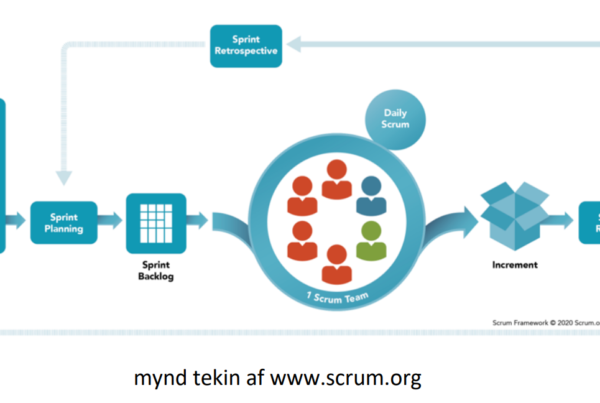Are you aware of developing the company’s products and services – to solve real problems for the customer? You can learn this from customer-driven innovation and service design.
For any business, it is crucial not to end up in the back game. But in a hectic everyday life, it’s easy to have your nose so far down in the keyboard and work towards the next deadline, that you forget to see the big picture.
The fact is that renewal is about far more than just the technological. All the world’s technical solutions are in vain if they do not solve real problems for your customers.
Precisely for this reason, a common denominator for the companies that succeed with renewal is that they are based on the users’ experiences, challenges and expectations.
One starts with the problem – not the solution. This is a basic principle in innovation methodology called service design, or design thinking.
What is service thinking?
Service design is about putting the user / customer in the driver’s seat when working with innovation. The term service design is used here in a broad sense, similar to the English design thinking .
Design thinking or service design means starting with the problem instead of the solution; to involve users and customers early in the process, and to work interdisciplinary and holistically to arrive at the products and services that best solve the target group’s real needs.
It is a method and a mindset that can and should be used by all types of companies, not just those who in the narrow sense work with “design”.
So it pays to take a step back with the customers, and hear from them how it really goes. This way you can make sure that your company is on the right track, or if you need to make the necessary adjustments.
Innovation very rarely comes out of the blue – you must actively search for new opportunities for your business. You can get many new ideas for products and services, simply by talking to your customers.Workshop: Customer-driven innovation
Have an open mind
The challenge for many is that such conversations end up far down the priority list in a hectic workday – they think that such a survey is a waste, because you know your market. That’s rare. In fact, it can open up new fresh ideas and improve collaboration with customers.
Before you get started, there are some things that are important to keep in mind:
- Have an open mind and do not contradict the customer. The purpose is to find out from their experiences, not defend their own business
- You know your customer best, and thus know what questions you should ask. Do not follow the questionnaire slavishly or think that “one size fits all”
- Take notes along the way – and feel free to let us know. If the person you are talking to moves too fast, you can always ask the person to repeat. You come a long way with a light-hearted comment that you stroked the touch method at school
So: How do you conduct a meaningful customer conversation? Here are seven suggestions for questions you can ask customers:
1. What are the most important challenges you face?
If you have a close dialogue with the customer as usual, you may think that you already have a full overview of their challenges. But remember that many problems only become apparent afterwards. And maybe they’re annoyed about something they did not want to take with you – either because of cost or time pressure.
Giving the customer the opportunity to talk freely about their challenges – in an earmarked conversation – increases the chance that you will get a more complete picture.
Maybe a space of opportunity opens up that has not been clear before? It can also have a lot to say for further cooperation, in that you appear as a serious and reliable partner, who wishes the customer the very best.
2. In what contexts do you use our products / services – and what are you trying to achieve with them?
You have started by talking about the customer’s needs and issues more generally. Now you can turn the conversation into how and why they use their products and services.
In what situations and contexts do they use the product / service? What are they trying to achieve in these contexts, and what is the difficulty with this?
During the conversation, you may see that you do not solve the problem completely – or do not completely solve the right problem.
3. How satisfied are you with our products / services?
Here it is important that you listen to the customer. After all, the purpose of such a conversation is not to defend the product, service or choices you have made – but to uncover room for innovation and renewal.
Therefore: Ask the customer directly how satisfied they are. Then you get a clear indication of where in the country they are. You can follow this up with…
4. Why are you satisfied / dissatisfied?
Again: Listen to the customer. There is no point in asking them to be sincere, if you are not willing to accept rice as well as praise. Let the customer embroider the overall picture. You will not go far in knowing that they are dissatisfied with a particular functionality – you need to know why and how it affects their business.
An honest feedback can be difficult to swallow – but provides far more concrete guidelines for what you can work on.
5. What do you miss?
It is not always so easy to see your own business from the outside – at least not for you. Your customers, on the other hand, will be well positioned to think outside the box you operate with.
With this question, you let the customer think freely. Maybe they’re suggesting a plugin that is not possible to implement at this time, or a feature you yourself have not thought of. If it’s important to the customer, should not you then put all the cloths on to make it possible?ALSO READ– You can get a completely new business idea already in the workshop
6. What specific problem do you have with the service / product?
This may appear somewhat repetitive, but there is a meaning behind it. By starting with a more general question, you can then take a more concrete approach and dig deeper into what the customer has on their minds. First you get an overview, then you dive into the challenges of the specific services or their products.
Not only do you get a clearer overall picture – you also want to ensure that the customer does not omit or anything.
7. Do you have suggestions for improvements or new solutions?
You may have answered this question up to several times during the call. Still, it’s worth having on the block – after all, that’s why you’re calling.
Let the user think freely and do not make objections or apologies. You will not stifle potentially fruitful ideas by standing on your hind legs. If the customer has already suggested improvements or new solutions, ask if it comes up with any more.
8. How satisfied / dissatisfied are you with the dialogue with us?
The answer to this question can also be a little uncomfortable to get, but it can be invaluable for their further cooperation. If there are speed bumps in the communication between you, you need to know about them.
Even an almost flawless user experience can be impaired by poor or lack of user support. It may be that it has taken a very long time to provide user access to the computer system for new employees, or something as simple as that the customers have not received sufficient information about new deliveries.
By uncovering inadequate communication, you can nurture the customer relationship – and perhaps discover new business opportunities.
Make the customer the hero
When the conversation is over, you should set aside some time to rewrite the notes and systematize the information. Based on the insight you get from this and other customers, you should namely consider how your business will work in the future.
Remember that this does not have to be an extraordinary conversation. You probably already have a good tone and regular contact with several customers. It’s just as much about a mindset, and an awareness. A conversation dedicated to mapping customers’ perspectives, making their needs and prerequisites the hero.
This ensures that you are turned on when you are in contact with the customer, and that you have your ears open for what issues they have – which you may be able to help solve.
Höfundur greinar er Digital Norway.



